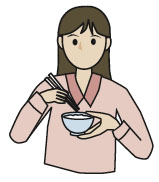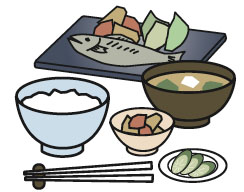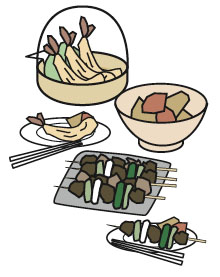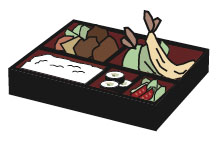Preparing yourself for Japanese Dining
Holding the bowl in your hand is basic to Japanese dining.
Of course it is not European style to pick up the plate or bowl with your hand, but in Japanese dining the smaller crockery, such as the rice and soup bowls, the small plates and even the larger donburi rice bowl are supposed to be held or supported when eating, and mothers throughout Japan can be heard every night admonishing their little ones to “hold your bowl”. Of course, large serving dishes, such as plates bearing sashimi, grilled fish or tempura are best left on the table.
Let’s start by picking up the rice bowl.
 The Japanese hold the rice bowl in their left hand (or right hand for left-handed people) to start in on their food; sort of like a soldier holding a shield. The chopsticks are used deftly to reach out for the delicately portioned food. Then, you dish a piece of okazu (the food that accompanies the rice, such as meat, fish, vegetable, tempura etc) onto the top of your rice to rest for a moment, and from there it is a simple matter to lift it, together with a little of the rice, into your mouth. Throughout most of the meal the rice bowl remains in your hand and the meal is supposed to be enjoyed using the rice as a base for the other food. It is perfectly OK to exchange the rice bowl for the miso soup bowl, and to drink the soup directly from the bowl (this bowl is actually considered to be a kind of cup in Japan – think of a latte bowl for example).
The Japanese hold the rice bowl in their left hand (or right hand for left-handed people) to start in on their food; sort of like a soldier holding a shield. The chopsticks are used deftly to reach out for the delicately portioned food. Then, you dish a piece of okazu (the food that accompanies the rice, such as meat, fish, vegetable, tempura etc) onto the top of your rice to rest for a moment, and from there it is a simple matter to lift it, together with a little of the rice, into your mouth. Throughout most of the meal the rice bowl remains in your hand and the meal is supposed to be enjoyed using the rice as a base for the other food. It is perfectly OK to exchange the rice bowl for the miso soup bowl, and to drink the soup directly from the bowl (this bowl is actually considered to be a kind of cup in Japan – think of a latte bowl for example).
The diner is presented with all the dishes.
 In a Japanese meal, each diner is presented with set of miso soup, rice, main dish and small dishes all set on the table at once. Basically they do not arrive in an order such as entree, soup, main, and dessert; (although of course some restaurants and households have adopted such Western systems).
In a Japanese meal, each diner is presented with set of miso soup, rice, main dish and small dishes all set on the table at once. Basically they do not arrive in an order such as entree, soup, main, and dessert; (although of course some restaurants and households have adopted such Western systems).
The various flavours can be mixed inside the mouth.
Traditionally, Japanese food is designed so that the various flavours can be mixed inside the mouth. This is different to European food styles where the flavours are mixed on the dish; the sauces, potatoes and meat of the European and American dining culture often all being thrown together on one plate.
Of course, being flexible and adaptable the Japanese have also developed their own ways to enjoy food efficiently such as the donburi (rice-bowl-with-topping) and the nabe (pot stew) where various elements are combined in a single plate.
Order a number of dishes to share.
 At an izakaya (dining bar), the idea is to order a number of dishes from the menu for everyone at the table to share. The wisdom of this is that everyone gets to enjoy a variety of tastes (just don’t get into an argument when the time comes to pay the bill). Having shared the food, the diners generally divide the bill evenly amongst themselves. It is not customary to try to pay only for what you have had yourself; with the inevitable result that there are sometimes cries of “unfair” from those who could not partake in the evening’s alcohol consumption.
At an izakaya (dining bar), the idea is to order a number of dishes from the menu for everyone at the table to share. The wisdom of this is that everyone gets to enjoy a variety of tastes (just don’t get into an argument when the time comes to pay the bill). Having shared the food, the diners generally divide the bill evenly amongst themselves. It is not customary to try to pay only for what you have had yourself; with the inevitable result that there are sometimes cries of “unfair” from those who could not partake in the evening’s alcohol consumption.
We recommend that beginners order a gozen or set menu.
 To discover the dishes that will become your favorites, we recommend that beginners order a gozen or set menu, while more experienced diners should try ordering various dishes to share among friends*. There is no such thing as a poor combination, so you can order with confidence.
To discover the dishes that will become your favorites, we recommend that beginners order a gozen or set menu, while more experienced diners should try ordering various dishes to share among friends*. There is no such thing as a poor combination, so you can order with confidence.
*Note that sharing is not so common in a business setting.

